Samsung Portable SSD T3 Review
by Ganesh T S on February 22, 2016 10:00 AM ESTSynthetic Benchmarks - ATTO and Crystal DiskMark
Samsung claims sequential read and write speeds of up to 450 MBps, and these are backed up by the ATTO benchmarks provided below. Unfortunately, these access traces are not very common in real-life scenarios.
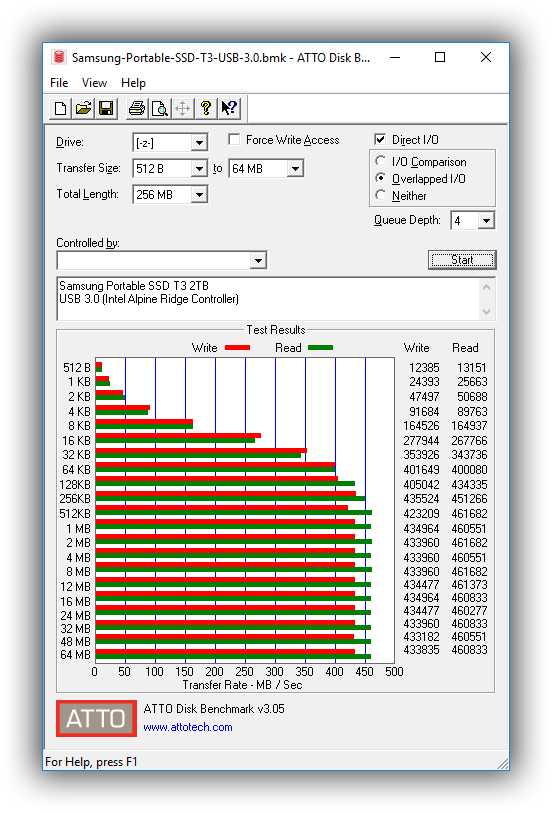
CrystalDiskMark, despite being a canned benchmark, provides a better estimate of the performance range with a selected set of numbers. As evident from the screenshot below, the performance can dip to as low as 20.68 MBps for random 4K reads. The presence of DRAM helps boost the performance quite a bit.
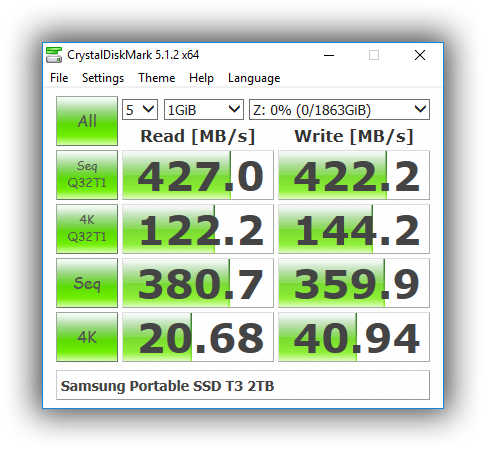
Benchmarks - robocopy and PCMark 8 Storage Bench
Our testing methodology for DAS units also takes into consideration the usual use-case for such devices. The most common usage scenario is transfer of large amounts of photos and videos to and from the unit. The minor usage scenario is importing files directly off the DAS into a multimedia editing program such as Adobe Photoshop.
In order to tackle the first use-case, we created three test folders with the following characteristics:
- Photos: 15.6 GB collection of 4320 photos (RAW as well as JPEGs) in 61 sub-folders
- Videos: 16.1 GB collection of 244 videos (MP4 as well as MOVs) in 6 sub-folders
- BR: 10.7 GB Blu-ray folder structure of the IDT Benchmark Blu-ray (the same that we use in our robocopy tests for NAS systems)






In almost all the cases, we find that the performance of the T3 slightly lags the performance of the T1. However, it is still faster than most other SSDs behind a SATA - USB bridge chip.
For the second use-case, we take advantage of PC Mark 8's storage bench. The storage workload involves games as well as multimedia editing applications. The command line version allows us to cherry-pick storage traces to run on a target drive. We chose the following traces.
- Adobe Photoshop (Light)
- Adobe Photoshop (Heavy)
- Adobe After Effects
- Adobe Illustrator
Usually, PC Mark 8 reports time to complete the trace, but the detailed log report has the read and write bandwidth figures which we present in our performance graphs. Note that the bandwidth number reported in the results don't involve idle time compression. Results might appear low, but that is part of the workload characteristic. Note that the same testbed is being used for all DAS units. Therefore, comparing the numbers for each trace should be possible across different DAS units. These benchmarks also point to the T3 being slightly behind T1 in performance.


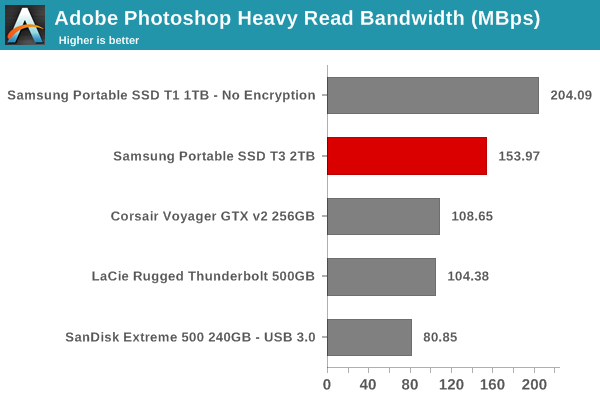


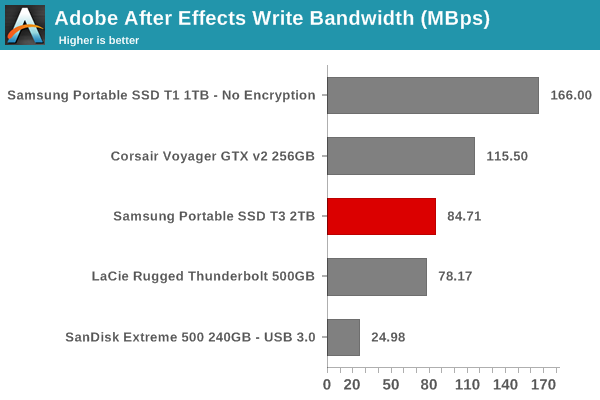
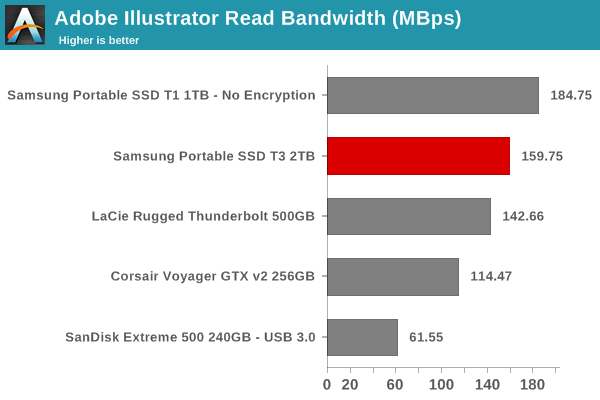











49 Comments
View All Comments
cm2187 - Monday, February 22, 2016 - link
Do these things have power loss protection? That's what I would be the most concerned about with a portable SSD.darkfalz - Monday, February 22, 2016 - link
You'd hope with the relatively low power requirement there'd be capacitors with power enough to flush internal RAM to NV.cm2187 - Monday, February 22, 2016 - link
Well... I assume nothing. Given the cost of a capacitor all SSD should have power loss protection, but as far as I know none of the 850 EVO and Pro have any.nathanddrews - Monday, February 22, 2016 - link
I agree that they all should, but especially an external/mobile SSD.theduckofdeath - Wednesday, February 24, 2016 - link
Power loss protection shouldn't be inside a drive. It requires batteries to be useful without degrading performance. If it's essential to you, get a SATA controller with battery backed WBC. On consumer devices, this kind of protection is usually handled by the operating system, to an extent. Like, if you disconnect a USB device from a Windows 10 device, Windows should be able to pause and resume your write jobs whenever you reconnect the USB drive.NeatOman - Friday, March 11, 2016 - link
Power Loss Protection doesn't really "require" batteries, and a few capacitors or just one is enough for a SSD and that's exactly what you get when you buy a real enterprise grade SSD. With that said, HDD with full power loss protection in servers do have a battery, which is what i think you're thinking about.vortexmak - Monday, February 22, 2016 - link
How did it force format to FAT32?Isn't the FAT32 filesystem limited to 32 GB?
Maboroshi - Monday, February 22, 2016 - link
originally FAT32 had a limit of one byte less than 4GB (for some reason) but current implementations allow for up to 16TB depending on how it's formatted. (depending on sector size it is 2, 8 or 16 TB maximum)hojnikb - Monday, February 22, 2016 - link
Thats not true at all. FAT32 was never limited to 4GB, it was always 2TB+ (depending on the secotor size).4GB is the single file limit.
GU - Saturday, February 27, 2016 - link
I think you mean 2TB- not +. For 2TB+ you need UEFI BIOS and GPT partition table, with which well... you can have Fat32 partitions but each limited to 2TB (1.7TB) to be exact.